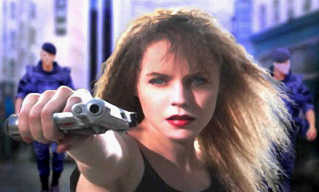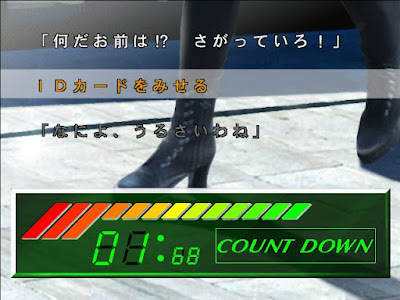Ask any Dreamcast fan about Capcom's legacy on the console and you'll be told that good old Cappy are probably as synonymous with the box of dreams as even Sega themselves. Then, if you asked those same fans what kind of games they'd associate Capcom's mighty stint on the Dreamcast with, they'd most likely tell you "fighters", maybe even shoot-em-ups or survival horror. No one, and I repeat, no one would respond: "a text-based near future crime thriller featuring a digitised actress".
Bounty Hunter Sarah: Holy Mountain no Teiō was released onto the Dreamcast and PlayStation on the 24th of May 2001. Published by Capcom, this Japanese-exclusive "sound novel" (more on that in a moment) was developed by Flagship, a fresh-faced independent studio founded by ex-Capcom developer Yoshiki Okamoto. With funding from Capcom, Nintendo and Sega, Flagship would develop or assist with the development of games from huge franchises such as Resident Evil, Kirby and The Legend of Zelda, before sadly closing its doors in 2007. Bounty Hunter Sarah was Flagship’s first and only original IP, with its big selling point being that its plot was written by the same scenario writer as Resident Evil 2, Noboru Sugimura, who had also left Capcom to be part of Flagship.
 |
| The staff of Flagship at a 2001 presentation |
The game's plot takes place in the year 2060, and revolves around Sarah Fitzgerald, a bounty hunter who roams the crime-ridden Neo Tokyo with the goal of assassinating a notorious mafia boss known as the "Lord of the Holy Mountain". The game's action-packed opening cinematic sets this all up really well, with plenty of flashy stop-motion spy stuff and enough explosions to make Michael Bay blush. But then when you start a new game, all that energy witnessed in the intro suddenly takes a turn as you soon realise that Sugimura's plot is told in the form of a "sound novel," a type of game fairly similar to a visual novel. For those not in the know, visual novels are...well, novels that are visual.
Some would argue that they aren’t really games due to them essentially being flashy reading exercises, with little interaction required from the player other than to progress countless paragraphs of text with a single button and, in the case of the most common type of visual novel, have them occasionally select a choice. Despite their text heavy nature, they still include plenty of varying background scenery and colourful characters (usually anime-style) to accompany the stories being told, and often feature plot lines that can devolve down branching paths to multiple endings, leading some to liken visual novels to interactive choose your own adventure books. Sound novels, on the other hand, while still including a decent helping of artwork, often have it serve as a backdrop to screens filled with text, with the game instead relying more on sound effects and music to immerse the player into the plot taking place (source).
 |
| A typical visual novel (Air) vs. Bounty Hunter Sarah |
While it's definitely not going to give Power Stone a run for its money, Bounty Hunter Sarah still carries a level of quality that should be expected from a game displaying Capcom's famous blue and yellow seal. Its presentation is definitely one of its stronger suits over other sound novels from the same era, with plenty of cool imagery and varied angles to present the plot. Scenes including the digitised actress playing Sarah are rendered stylishly for the most part, appearing more like paintings as opposed to lazily spliced-in photos. Music and sound effects are also high quality and successfully set an atmosphere to be expected from such a gritty, dystopian premise.
The game really does present like a Western spy movie in a near future setting, just...a bit more static. Speaking at a presentation in April 2001, the game's producer Tatsuya Minami said: "Since [Bounty Hunter Sarah is] a sound novel with action, I think we were able to create a fast-paced game by using a lot of cinematic expressions and stop motion pictures." The game's mature tone was also referenced a lot as one of the things to set Bounty Hunter Sarah apart from its competition (source). Makes sense really, if you like the idea of visual novels but aren't really into the whole cutesy anime thing then this was definitely something a bit different.
The story uses two types of systems to allow players to make choices. One uses a 5 second countdown, usually in moments of action, where quick decision making is necessary. The other is a "thinking" mode, where players must reflect on the chapter they just played and make decisions on which actions they need to take next. The player is then given a letter ranking on the quality of the choices they made throughout the chapter. Once the game's first scenario is cleared (which can take up to two hours to complete), two more are unlocked. Completing all three with an "S" rank unlocks a final scenario. Definitely some cool mechanics to set this title apart from others in its genre.
Some Japanese players did have their gripes with the game though (source). The three scenarios required to unlock the final one don't differ significantly enough from one another, meaning you'd be spending around six hours or more playing what is effectively the same story just to get to the true end of the game. For those of us without any knowledge of Japanese, this would prove to be even worse, and even the most committed player could end up messing around with Google Translate for a very long time!
The game also uses a lot of terms (highlighted in blue in the text) unique to its setting for the purposes of world building, which it defines for you rather elaborately in a "keyword" menu which can be opened. These terms are littered throughout the text, meaning you'd really have to memorise their definitions to make sense of them in context. The game doesn't let you view the definitions after you go to the next chapter, either, which is a bit silly.
 |
| Screenshot from Critical Bullet: 7th Target |
As another point of interest, I tried to find out the name of the actress who played Sarah. The game has no entry on IMDB or Wikipedia, and there is no mention of the actress on the few English websites I could find covering it. Undeterred, I decided the best place to find the actress' name would be the game's credits. As I couldn't slog my way through the game at any reasonable pace due to the language barrier, I hit up Nicovideo, a Japanese video-sharing website that I suspected might contain some gameplay footage. Sure enough, after searching for the game in Japanese, I instantly found a playthrough that showed the game's credits at the end (source). There, amongst all the Japanese names, one name appeared in English: "SHELLY SWEENEY."
Shelley Sweeney (they spelt her name wrong in the game's credits...oops!) is a Canadian actress and model whose work was primarily based in Japan. She's acted in multiple Godzilla movies, played roles in TV series like Super Sentai (aka Power Rangers) and even starred in Japanese adverts for products such as Asahi beer (source). Her foray into video games includes lending her voice to the English dub of Shenmue II (listed as "additional voices") and she was also a "steel model" (which I think is something related to motion capture) during the development of Clock Tower 3, another Flagship-assisted title with a scenario written by Noboru Sugimura.It was great to get Shelley’s confirmation, although I was still intrigued about the PR event she'd mentioned in her tweet. When I was researching the game, I found an article from 2001 on Japanese gaming site Game Watch that covered the April 2001 presentation I mentioned previously (source). As part of the presentation where the Flagship development team discussed Bounty Hunter Sarah, they actually had Shelley on stage playing the character. I asked her to confirm if this was the event she was referring to. Turns out it was!











2 comments:
This was all news to me so very fascinating. The detective work here was exciting to read, I adore it when you folks at the junkyard uncover another Dreamcast related mystery - brilliant. I love Shelly's enthusiasm for your article too. Amazing work Lewis.
Fantastic article Lewis, you keep smashing them out of the park! I had no prior knowledge of this game, that you also tracked down the cover artist / star is awesome.
Post a Comment